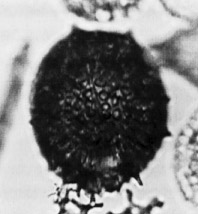 Sphaeropyle
robusta Kling
Sphaeropyle
robusta Kling Sphaeropyle
robusta Kling
Sphaeropyle
robusta KlingSphaeropyle robusta Kling, 1973, p.634, pl.1, figs.11-12, pl.6, figs.9-13, pl.13, figs.1-5
Four concentric shells. Innermost shell robust, spherical, with circular pores of uniform size, irregularly arranged, 34 per half-circumference. Second shell (outward) robust, spherical, with circular pores of fairly uniform size, quincuncially arranged, 6-7 per half-circumference, weakly framed. Third shell, usually relatively thin-walled (particularly in later representatives), spherical to subspherical, with circular pores of variable size but conspicuously large relative to other shells, 7-9 per half-circumference, with tiny by-spines at most bar intersections. Cortical shell robust, subspherical to elongate, protruding at one end, bearing a pylome that is surrounded with a corona of stout teeth; pores circular, irregularly arranged, usually with well-developed frames, about 20 per half-circumference; bar intersections often developed into short by-spines.
Approximately 6 radial bars connect the inner three shells, many times this number between cortical and next inner shell. Stout radial main-spines are usually short in Leg 18 material, but appear broken and could be better developed (preserved) elsewhere (Kling, 1973).
Based on 10 specimens (younger material). Diameter of innermost shell 16-18 µm, second shell 40-46 µm, third 100-110 µm, cortical (small diameter) 146-200 µm.
Based on 10 specimens (older material). Diameter of innermost shell 10-20 µm, second shell 30-44 µm, third 62-100 µm, cortical 98-15 µm (Kling, 1973)
This species differs from S. langii, its apparent descendant, primarily in its more robust cortical shell with framed pores. S. langii is generally smaller with a thin cortical shell bearing simple, cylindrical pores (Kling, 1973).
S. robusta could not be distinguished from S. langii on the basis of the relative robustness of the outer shell. Instead it is distinguished from S. langii by its second shell, which has distinctly smaller pores, more regular in size. Using the size and regularity of the pores of the second shell as the criterial for distinguishing these two species gives a somehat longer morphological range for S. langii than indicated by Kling (1973) (Foreman, 1975).
Earlier populations are smaller with peristomal teeth fused into a rim. They are otherwise similar although it may eventually be possible to separate these forms as a new species (Kling, 1973).
This species is found in high and middle-latitude sediments. Its morphotypic last appearance lies within the Eucyrtidium matuyamai Zone in the North Pacific. Its morphotypic first appearance is in the early Miocene.
Ancestry unknown, but its evolutionary transition to Sphaeropyle langii occurs near the Pliocene-Pleistocene boundary.